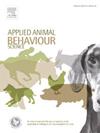Should the cocktail training method cause a stir? Training frog generalist detection dogs with combined species samples
IF 2.2
2区 农林科学
Q1 AGRICULTURE, DAIRY & ANIMAL SCIENCE
引用次数: 0
Abstract
Wildlife detection dog (WDD) and handler teams can greatly support conservation efforts. Sourcing odourant samples to train these teams is challenging. One option involves training WDDs on common species, from which samples are more accessible, in the hope they will generalise to similar endangered species. Cocktail (mixture) training, where dogs are trained on samples that purposefully contain multiple odourants (e.g. frog species), may be suitable for rapidly training dogs on multiple species. Presently, there is confounding evidence of animals’ abilities to recognise individual components within mixtures. Our study aimed to determine whether training dogs with ‘frog cocktails’ of five different frog species would facilitate generalisation to novel (i.e. previously unencountered) frog species. Seven dogs were trained on five varieties of ‘frog cocktails’. Each cocktail contained skin swabs from four of the five frog species to minimise species odourant overshadowing. Training occurred indoors across 18 sessions on a 12-armed scent wheel. Double-blind assessments were then completed to determine whether dogs recognised each cocktail component (Species A – E). The dogs were assessed on each of the five species (10 trials per species) to measure sensitivity and precision. Lastly, the dogs were assessed on their ability to generalise to novel frog species (Species F – J). When the dogs were tested on cocktail components, they demonstrated poor species recognition, detecting frogs in 16/35 searches. Sensitivity and precision were highly varied between dogs and across frog species, with a mean sensitivity of 60.8 % and precision of 43.6 %. During novel frog species assessments the dogs demonstrated higher generalisation, alerting to 23/30 novel frog species. The majority of dogs scored highly for sensitivity and precision across these novel species assessments, with a mean sensitivity of 81.7 % and precision of 72.9 %. Our results demonstrate the dogs’ relatively poor recognition of the cocktail components following training, presumably because they were likely processing the cocktails as a whole, rather than as a collection of unique odourants. Their ability to process the cocktails elementally may have improved with a longer training period. However, as a result of this cocktail training and a series of assessments on individual cocktail components, the dogs were able to generalise to novel frog species, suggesting the dogs understood the target category of ‘frog’. Our study highlights considerations for employing the cocktail training method, as well as potential benefits of this training for endangered wildlife detection.
这种鸡尾酒训练方法应该引起轰动吗?用组合物种样本训练青蛙多面手探测犬
野生动物探测犬(WDD)和训练员团队可以极大地支持保护工作。寻找气味样本来培训这些团队是一项挑战。一种选择是对wdd进行常见物种的培训,因为这些物种的样本更容易获得,希望它们能推广到类似的濒危物种。鸡尾酒(混合物)训练,狗在有目的地包含多种气味的样本(例如青蛙物种)上进行训练,可能适合快速训练狗在多种物种上。目前,有令人困惑的证据表明动物有能力识别混合物中的单个成分。我们的研究旨在确定用五种不同青蛙的“青蛙鸡尾酒”训练狗是否会促进对新(即以前未见过的)青蛙物种的概括。七只狗接受了五种“青蛙鸡尾酒”的训练。每种鸡尾酒都含有五种青蛙中的四种的皮肤拭子,以尽量减少物种气味的影响。训练是在室内进行的,为期18次,在一个12臂的气味轮上进行。然后完成双盲评估,以确定狗是否识别每种鸡尾酒成分(物种A - E)。研究人员对5个品种的狗进行了评估(每个品种10次试验),以衡量它们的灵敏度和精确度。最后,评估了狗对新蛙种(物种F - J)的概括能力。当对狗进行鸡尾酒成分测试时,它们表现出较差的物种识别能力,在16/35的搜索中发现了青蛙。灵敏度和精密度在犬种和蛙种之间差异很大,平均灵敏度为60.8 %,精密度为43.6 %。在新蛙种评估中,狗表现出更高的泛化能力,能对23/30的新蛙种发出警报。大多数狗在这些新物种评估中的灵敏度和精度得分很高,平均灵敏度为81.7 %,精度为72.9 %。我们的研究结果表明,经过训练后,狗狗对鸡尾酒成分的识别能力相对较差,这可能是因为它们可能将鸡尾酒作为一个整体来处理,而不是作为一种独特气味的集合。他们处理鸡尾酒的基本能力可能会随着更长的训练时间而提高。然而,由于这种鸡尾酒训练和对单个鸡尾酒成分的一系列评估,狗能够概括出新的青蛙物种,这表明狗理解了“青蛙”的目标类别。我们的研究强调了采用鸡尾酒训练方法的考虑因素,以及这种训练对濒危野生动物检测的潜在好处。
本文章由计算机程序翻译,如有差异,请以英文原文为准。
求助全文
约1分钟内获得全文
求助全文
来源期刊

Applied Animal Behaviour Science
农林科学-行为科学
CiteScore
4.40
自引率
21.70%
发文量
191
审稿时长
18.1 weeks
期刊介绍:
This journal publishes relevant information on the behaviour of domesticated and utilized animals.
Topics covered include:
-Behaviour of farm, zoo and laboratory animals in relation to animal management and welfare
-Behaviour of companion animals in relation to behavioural problems, for example, in relation to the training of dogs for different purposes, in relation to behavioural problems
-Studies of the behaviour of wild animals when these studies are relevant from an applied perspective, for example in relation to wildlife management, pest management or nature conservation
-Methodological studies within relevant fields
The principal subjects are farm, companion and laboratory animals, including, of course, poultry. The journal also deals with the following animal subjects:
-Those involved in any farming system, e.g. deer, rabbits and fur-bearing animals
-Those in ANY form of confinement, e.g. zoos, safari parks and other forms of display
-Feral animals, and any animal species which impinge on farming operations, e.g. as causes of loss or damage
-Species used for hunting, recreation etc. may also be considered as acceptable subjects in some instances
-Laboratory animals, if the material relates to their behavioural requirements
 求助内容:
求助内容: 应助结果提醒方式:
应助结果提醒方式:


